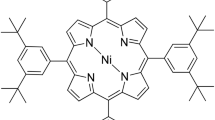Abstract
In this work, the sensitivity and linearity properties of capacitive based titanium dioxide (TiO2) humidity microsensors with different materials used as electrodes have been investigated. The TiO2 thin films were grown on either Ti or TiN microinterdigitated structure as contact electrodes utilizing glancing angle deposition (GLAD) electron beam evaporator. The crystallinity and surface morphology of the prepared thin films were characterized by field emission scanning electron microscope (FE-SEM). The anatase phase structure of TiO2 thin films and the porous-like nanocrystalline TiO2 films sculptured by GLAD has been observed. The sensitivity of TiO2/Ti-electrode and TiO2/TiN electrode humidity sensors have been measured by current–voltage and capacitance–voltage. The capacitive sensors with Ti electrodes show better sensitivity and linearity than the sensors with TiN electrodes. The results show that the sensitivity of 1.17 × 10–11 F/%RH and linearity of 0.97 were achieved for our sensor with Ti microinterdigitated electrodes and porous-like nanocrystalline TiO2 films grown at 70° glancing angle.










Similar content being viewed by others
Data availability
This manuscript has no associated data.
References
C. Ku, C. Chung, Advances in humidity nanosensors and their application: Review. Sensors. 23, 2328 (2023)
Z. Duan, Y. Jiang, H. Tai, Recent advances in humidity sensors for human body related humidity detection. J. Mater. Chem. C. 9, 14963–14980 (2021)
N.M. Pereira, N.P. Rezende, T.H.R. Cunha, A.P.M. Barboza, G.G. Silva, D. Lippross, B.R.A. Neves, H. Chacham, A.S. Ferlauto, R.G. Lacerda, Aerosol-printed MoS2 ink as a high sensitivity humidity sensor. ACS Omega 7, 9388 (2022)
U. Kang, K.D. Wise, A high-speed capacitive humidity sensor with on-chip thermal reset. IEEE Trans. Electron Devices 47, 702–710 (2000)
J.R. McGhee, J.S. Sagu, D.J. Southee, P.S.A. Evans, K.G.U. Wijayantha, Printed, fully metal oxide, capacitive humidity sensors using conductive indium tin oxide inks. ACS Appl. Electron. Mater. 2(11), 3593–3600 (2020)
Z.M. Rittersma, Recent achievements in miniaturised humidity sensors–a review of transduction techniques. Sens. Actuators A Phys. 96, 196–210 (2022)
S. Mishra, A.K. Singh, Optical sensors for water and humidity and their further applications. Coord. Chem. Rev. 445, 214063 (2021)
G. Korotcenkov, Handbook of humidity measurement, vol. 2: electronic and electrical humidity sensors, (CRC Press, 2019)
B.A. Kuzubasoglu, Recent studies on the humidity sensor: a mini review. ACS Appl. Electron. Mater. 4, 4797–4807 (2022)
Y. Miao, H. Lin, B. Li, T. Dong, C. He, J. Du, X. Zhao, Z. Zhou, J. Su, H. Wang, Y. Dong, B. Lu, L. Dong, H.H. Radamson, Review of Ge(GeSn) and InGaAs avalanche diodes operating in the SWIR spectral region. Nanomaterials 13, 606 (2023)
Y. Miao, G. Wang, Z. Kong, B. Xu, X. Zhao, X. Luo, H. Lin, Y. Dong, B. Lu, L. Dong, J. Zhou, J. Liu, H.H. Radamson, Review of Si-based GeSn CVD growth and optoelectronic applications. Nanomaterials 11, 2556 (2021)
M. Akbari-Saatlu, M. Procek, C. Mattsson, G. Thungström, H. Nilsson, W. **ong, B. Xu, Y. Li, H.H. Radamson, Silicon nanowires for gas sensing: a review. Nanomaterials 10, 2215 (2020)
M. Zhao, W. Zhu, X. Feng, S. Yang, Z. Liu, S. Tang, D. Chen, Q. Guo, G. Wang, G. Ding, Role of interfacial 2D graphene in high performance 3D graphene/germanium Schottky junction humidity sensors. J. Mater. Chem. C. 8, 14196 (2020)
J. Samà, M.S. Seifner, G. Domènech-Gil, J. Santander, C. Calaza, M. Moreno, I. Gràcia, S. Barth, A. Romano-Rodríguez, Low temperature humidity sensor based on Ge nanowires selectively grown on suspended microhotplates. Sens. Actuators B 243, 669–677 (2017)
P. Nowak, W. Maziarz, A. Rydosz, K. Kowalski, M. Ziabka, K. Zakrzewska, SnO2/TiO2 thin film n-n heterostructures of improved sensitivity to NO2. Sensors 20, 6830 (2020)
A.T. Wu, M. Seto, M.J. Brett, Capacitive SiO humidity sensors with novel microstructures. Sens. Mater. 11, 493–505 (1999)
A. Barranco, A. Borras, A.R. González-Elipe, A. Palmero, Perspectives on oblique angle deposition of thin films: from fundamentals to devices. Prog. Mater. Sci. 76, 59–153 (2016)
H.H. von Radamson, A. Hallén, I. Sychugov, A. Azarov, in Analytical Methods and Instruments for Micro- and Nanomaterials, 1st edn. (Springer, Cham, 2023), pp.197–240
V.E. Vrakatseli, A.N. Kalarakis, A.G. Kalampounias, E.K. Amanatides, D.S. Mataras, Glancing angle deposition effect on structure and light-induced wettability of RF-sputtered TiO2 thin films. Micromachines 9, 389 (2018)
M. Liu, C. Wang, N. Kim, High-sensitivity and low-hysteresis porous MIM-type capacitive humidity sensor using functional polymer mixed with TiO2 microparticle. Sensors 17, 284 (2017)
Funding
The authors declare that no funds, grants, or other support were received for conducting the experiments in this manuscript.
Author information
Authors and Affiliations
Contributions
All authors contributed to the study conception and design. Material preparation, data collection and analysis were performed by PP. The first draft of the manuscript was written by PP and all authors commented on previous versions of the manuscript. All authors read and approved the final manuscript.
Corresponding author
Ethics declarations
Competing interests
The authors have no relevant financial or non-financial interests to disclose.
Additional information
Publisher's Note
Springer Nature remains neutral with regard to jurisdictional claims in published maps and institutional affiliations.
Rights and permissions
Springer Nature or its licensor (e.g. a society or other partner) holds exclusive rights to this article under a publishing agreement with the author(s) or other rightsholder(s); author self-archiving of the accepted manuscript version of this article is solely governed by the terms of such publishing agreement and applicable law.
About this article
Cite this article
Phinmuang, P., Ekpanyapong, M. The effect of metal electrodes and deposition angle on linearity of sculptured TiO2 humidity microsensors. J Mater Sci: Mater Electron 35, 574 (2024). https://doi.org/10.1007/s10854-024-12321-0
Received:
Accepted:
Published:
DOI: https://doi.org/10.1007/s10854-024-12321-0




